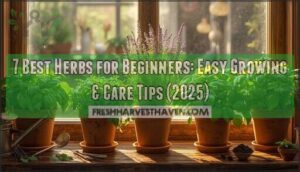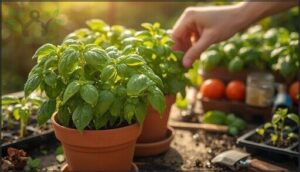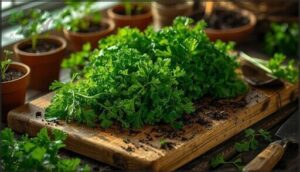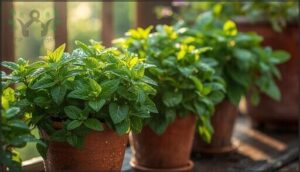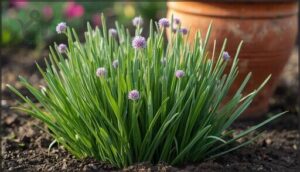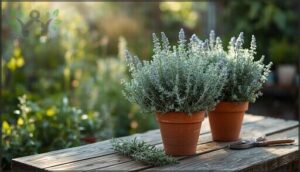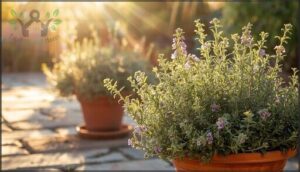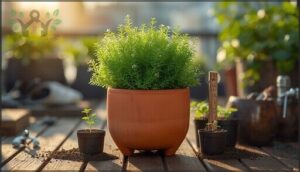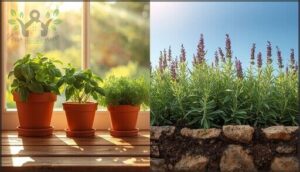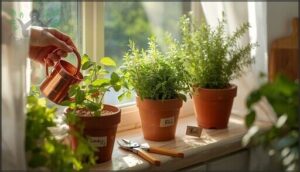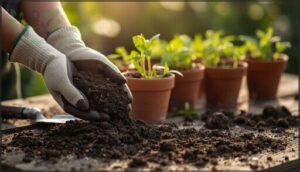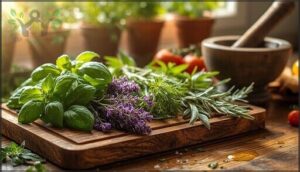This site is supported by our readers. We may earn a commission, at no cost to you, if you purchase through links.
Growing your own herbs doesn’t require a green thumb or years of gardening experience. Some herbs practically grow themselves—they’re nearly impossible to kill and actually prefer a bit of neglect. Whether you’re working with a sunny windowsill or a small patio, beginner-friendly herbs like mint, chives, and oregano adapt to different conditions and bounce back from rookie errors.
You can harvest fresh basil for your pasta within a month of planting, and parsley will forgive almost every watering mistake you make. These seven herbs will give you fresh flavor for your kitchen while building your confidence as a gardener, proving that homegrown doesn’t have to mean complicated.
Table Of Contents
- Key Takeaways
- Top Beginner-Friendly Herbs to Grow
- Easiest Herbs for Indoor and Outdoor Gardens
- Simple Herb Care and Maintenance Tips
- Soil and Growing Conditions for Beginners
- Culinary and Health Benefits of Beginner Herbs
- Frequently Asked Questions (FAQs)
- Are herbs easy to grow?
- What are the best herbs for beginners?
- Should you start with easy herbs?
- What herbs grow well in the kitchen?
- What is a good herb to grow in a garden?
- What herbs are good for cooking?
- What are the best herbs to grow for beginners?
- What are the beginner medicinal herbs?
- What is the best herb to take daily?
- Are herbs good starter plants?
- Conclusion
Key Takeaways
- Beginner-friendly herbs like basil, parsley, mint, and chives forgive watering mistakes and adapt to various growing conditions, with basil ready to harvest in just 3-4 weeks and most herbs succeeding for 90% of first-time growers.
- These seven herbs thrive with minimal care when you provide well-draining soil, 6-8 hours of sunlight daily, and avoid overwatering—the most common mistake that affects over 85% of struggling herb gardens.
- Regular harvesting and pruning (removing the top third of growth weekly for fast growers) encourages bushier plants and continuous production, while proper timing matters since delicate herbs like basil lose flavor if cooked too long.
- Home-grown herbs deliver impressive nutritional benefits, including parsley’s 547% daily vitamin K per half cup, and retain 65-80% of their antioxidant content for six months after drying, while saving 60-75% on grocery herb costs.
Top Beginner-Friendly Herbs to Grow
Starting an herb garden doesn’t have to be complicated. The best herbs for beginners are the ones that forgive mistakes, grow reliably, and give you plenty to harvest.
Here are seven herbs that make it easy to get your hands dirty and enjoy fresh flavors from your garden.
Basil – Fast-Growing and Versatile
Basil tops every beginner’s herb gardening list for good reason. You’ll see your first sprouts in just 5 to 10 days, and you can start harvesting leaves in as little as 3 to 4 weeks. This fast-growing powerhouse works beautifully in pesto recipes and pairs well with tomatoes through companion planting.
Different basil varieties offer unique flavor profiles, from sweet Italian to spicy Thai types. To encourage bushy growth and prevent flowering, try pinching back leaves.
Parsley – Multipurpose Kitchen Staple
Parsley varieties like flat-leaf and curly bring different flavors to your kitchen. Growing parsley takes patience—seeds need 14 to 21 days to sprout—but this biennial herb rewards you with steady harvests.
Parsley nutrition is impressive, delivering 1367% of your daily vitamin K per 100 grams. Its culinary uses span salads to sauces, while health benefits include antioxidant properties that support kidney function. Parsley is so nutritious that it earns 3 Guiding Stars for its nutritional value.
Mint – Hardy and Productive
Mint varieties like spearmint and peppermint are nearly foolproof for beginners. These hardy perennials grow 1 to 2 feet tall and handle various conditions beautifully. Watch out for invasive growth—mint’s aggressive roots spread fast, so containers work best for pest control and space management.
Here’s what makes mint economics appealing:
- Multiple harvests per season deliver fresh leaves continuously
- Plants produce up to 600 grams per square meter
- Mint propagation through cuttings costs you nothing
- Home growing slashes herb expenses by 60-75%
Chives – Low Maintenance and Flavorful
Chives rank among the easiest herbs to grow, returning year after year in zones 3-9 with minimal fuss. These perennial favorites offer a mild onion flavor for culinary uses and grow happily in containers or garden beds.
Chive propagation through division every 3-4 years keeps plants vigorous while expanding your herb collection. Regular harvesting promotes fresh growth, and companion planting near vegetables naturally deters pests.
Growing problems? Practically none—just avoid overwatering.
Sage – Easy for Cooking and Care
For growing herbs for beginners, sage varieties offer impressive pest control and resilience. This culinary herb thrives with minimal herb plant care—just provide well-draining soil and 6-8 hours of sunlight. Pruning techniques in spring keep plants productive, and health benefits include outstanding vitamin K and calcium content.
Culinary pairings with poultry, pumpkin, and butternut squash make sage essential in your herb garden tips collection.
Oregano – Thrives in Sunny Spots
With oregano, you’re growing herbs that practically run on sunshine. This hardy herb thrives in sunny spots with 6-8 hours of daily light, rewarding you with intense flavor and impressive climate resilience.
Here’s what makes oregano ideal for your herb garden tips collection:
- Sunlight needs: Full sun boosts oil content up to 6.6%
- Soil pH: Tolerates 6.0-8.0 range beautifully
- Water levels: Prefers drier conditions with excellent drainage
- Herb growing conditions: Survives temperatures down to -15°C once established
- Yield potential: 200-1060g per plant depending on irrigation
Coriander – Great for Containers
If you’re short on garden space, coriander shines in container herb gardening. Choose a pot at least 25 cm deep to support its taproot, and fill it with a soil blend of 60% potting mix, 30% perlite, and 10% compost.
Keep germination temperature between 12°C and 22°C, make sure proper drainage needs are met, and you’ll have fresh cilantro in just 30-45 days.
Easiest Herbs for Indoor and Outdoor Gardens
Whether you’re growing herbs on a sunny windowsill or in your backyard garden, choosing the right varieties makes all the difference. Some herbs adapt beautifully to indoor spaces, while others really come alive outdoors with room to spread.
Let’s look at which herbs work best for different growing spots and what they need to thrive.
Herbs That Thrive on Windowsills
Your sunny windowsill can become a thriving herb garden with the right choices. Indoor herb gardening succeeds when you match herbs to light requirements and create stable conditions.
Here are easy herbs to grow indoors:
- Basil – needs 6-8 hours of direct sun and temperatures above 50°F
- Thyme and oregano – tolerate drier air and lower humidity levels
- Parsley and chives – adapt well to the temperature range of 65-70°F
- Mint – stays productive with consistent moisture and good pest control
Best Herbs for Container Gardening
Containers give you flexibility and control when herb gardening for beginners. Choose pots at least 4 inches wide with proper drainage solutions to prevent root rot—this simple step increases survival rates by over 70%. Use soilless potting mixes with perlite for better aeration.
Growing herbs indoors succeeds with basil, parsley, mint, and chives as easy herbs to grow. These thrive in containers when you meet their soil and sunlight requirements.
Sunlight and Temperature Preferences
Most herbs need at least 6 hours of direct sunlight daily for best sunlight and healthy growth. Basil, rosemary, and sage should be placed near a sunny windowsill where they’ll get full sun, while mint and chives tolerate partial shade.
Keep daytime temperatures between 65–75°F—ideal growing conditions that prevent common beginner mistakes like light variation stress. Inadequate light conditions reduce yield impact by up to 40%.
Simple Herb Care and Maintenance Tips
Once your herbs are planted, keeping them happy doesn’t take much effort. A few simple habits around watering, feeding, and trimming will help your plants thrive all season long.
Here’s what you need to know to keep your beginner herbs growing strong.
Proper Watering Techniques
Regarding watering herbs, less is often more. Check the top inch of soil—if it’s dry, your plants are ready for a drink. Most herbs do well with deep watering once or twice a week.
Watch for yellowing leaves or wilting, classic overwatering signs. Use drip systems or hand-water at the base to keep foliage dry and roots healthy.
Fertilizing for Healthy Growth
Once you’ve got watering down, fertilizer becomes the next piece of the puzzle. Organic fertilizers improve soil structure gradually, while synthetic options deliver nutrients faster.
Apply a balanced, water-soluble formula every 4–6 weeks during the growing season, but go easy—over-fertilization weakens flavor and invites disease. Your herbs don’t need much to thrive.
Pruning and Harvesting for New Growth
Regular pruning and harvesting techniques are where your herbs really come alive. When plants reach 6–8 inches tall, start pinching off the top 2 inches weekly to encourage bushier growth—especially with basil and mint. Cut just above a leaf node using clean, sharp scissors. This stimulates leaf growth and keeps plants from getting leggy. Fast-growing herbs need weekly trims, while woody types like rosemary require monthly attention for best results.
- Start pruning early when plants reach 6–8 inches to shape bushy growth without stressing young herbs
- Trim weekly for fast growers like basil and mint; prune monthly for woodier herbs such as rosemary and thyme
- Cut at the node where leaves meet stems to promote branching and prevent early bolting in leafy varieties
- Harvest one-third maximum at a time to maintain photosynthesis and support continuous, healthy production
- Stop pruning eight weeks before frost to allow perennial herbs time to harden off for winter
Preventing Common Herb Problems
Even healthy growth needs smart herb plant protection to keep pest control in herb gardens manageable. Watch for aphids clustering on new shoots—they multiply fast, doubling in a week—and check leaves weekly for yellowing or mold.
Good watering practices prevent root rot, while spacing plants right stops powdery mildew before it starts.
Natural solutions like neem oil handle most garden pests without harsh chemicals.
Soil and Growing Conditions for Beginners
Getting the soil and location right is half the battle when you’re starting your herb garden. Most herbs aren’t fussy, but they do have some basic needs regarding drainage, nutrients, and sunlight.
Let’s walk through the essentials so your herbs can settle in and thrive from day one.
Choosing The Right Soil Type
Most culinary herbs prefer soil with a pH between 6.0 and 7.5—your sweet spot for healthy growth. Soil texture matters too. Well-draining soil prevents root rot, which affects over 85% of struggling herb gardens.
For best results, choose loamy or sandy potting compost that balances moisture retention with drainage needs. All-purpose potting mix works beautifully for 90% of beginner herbs without specialty blends.
Preparing and Amending Soil
Before planting, test your soil pH and adjust it with lime if needed—apply at least 2–3 months early for gradual correction.
Mix in compost or aged manure to boost organic matter to 5–10%, improving soil structure and moisture retention.
Incorporate a balanced fertilizer into the top 4–6 inches, then clear weeds for well-draining soil that helps roots establish quickly.
Drainage and Moisture Needs
Without proper drainage, your herbs will struggle no matter how carefully you plant them. Well-draining soil keeps roots healthy by preventing waterlogging and root rot, while good moisture retention means you won’t need to water as often.
- Avoid soil compaction by loosening dense areas—it blocks drainage and limits oxygen to roots
- Add 30–40% drainage materials like perlite or bark fines to potting mixes for containers
- Check moisture levels regularly; most herbs thrive when soil stays between 21–40% moist
- Water 1–2 times weekly with proper drainage—overwatering causes more problems than underwatering
Best Garden Locations for Herbs
Choosing a sunny spot within easy reach of your kitchen makes all the difference in herb garden success. You’ll harvest more often—studies show up to 30% more—when your plants are close by, and most herbs need at least six hours of direct sunlight daily to thrive.
| Location Type | Best For | Light Conditions |
|---|---|---|
| Near kitchen door | Frequent harvesting | Full sun to partial shade |
| South/west-facing raised beds | Heat-loving herbs | 6+ hours direct sunlight |
| Sheltered garden spots | Wind-sensitive varieties | Filtered or morning sun |
Consider climate control through landscape integration. Placing herbs near walls or among existing plants reduces wind damage by nearly 20% and can extend your growing season by several weeks in urban microclimates.
Culinary and Health Benefits of Beginner Herbs
Growing your own herbs isn’t just about having fresh ingredients at your fingertips—it’s about filling your kitchen with flavors that can transform everyday meals.
Beyond the culinary magic, these beginner-friendly herbs pack surprising nutritional benefits that support your health in simple, natural ways.
Let’s explore how to make the most of your homegrown harvest, from cooking techniques to preserving methods and the wellness perks hiding in those fragrant leaves.
Cooking With Fresh Herbs
Fresh herbs turn simple dishes into something special. When cooking with fresh herbs, timing matters—delicate culinary herbs like basil lose their punch if cooked too long, so add them at the end. Hardy types like rosemary handle heat better.
Flavor layering works when you understand herb pairings and fresh vs. dried ratios. These herbs for cooking boost nutrition while bringing your meals to life.
Preserving Herbs for Later Use
You’ve got options when harvest time rolls around. Preserving your culinary herbs locks in their flavoring power for months ahead.
- Drying herbs using a dehydrator at 95°F–115°F takes 1–4 hours and keeps flavor strong—skip sun-drying methods, which can slash essential oils by 40%.
- Freezing herbs in ice cube trays maintains aroma for up to 12 months with solid nutrient retention.
- Refrigeration tips: Store in sealed bags for 3–7 days, or immerse stems in water for two weeks of freshness.
Nutritional and Medicinal Properties
Beyond their kitchen appeal, these herbs pack serious nutritional value. Parsley delivers 547% of your daily vitamin K in just half a cup, while basil offers impressive antioxidant content and essential amino acids. Mint’s medicinal properties include antimicrobial effects, and chives supply 177% of vitamin K per 100 grams.
These beginner herbs deliver extraordinary nutritional value, from parsley’s 547% daily vitamin K to mint’s antimicrobial properties and basil’s antioxidant-rich profile
| Herb | Vitamin Density | Mineral Richness | Health Impacts |
|---|---|---|---|
| Basil | 13% RDI vitamin K per tablespoon | Calcium, potassium, magnesium | Anti-inflammatory, cardio-protective |
| Parsley | 547% RDI vitamin K (30g) | Iron (20% daily), vitamin C (65%) | Antioxidant, reduces oxidative stress |
| Mint | Moderate vitamins | Phytochemicals | Antimicrobial, cancer-preventive activity |
| Chives | 177% daily vitamin K | 296mg potassium per 100g | Promotes electrolyte balance |
Your home-grown varieties retain 65–80% of their antioxidant content for six months after drying. That’s meaningful dietary fiber and medicinal uses built right into your everyday cooking.
Frequently Asked Questions (FAQs)
Are herbs easy to grow?
You could say herb gardening is a sage decision for beginner gardeners. Most herbs require minimal maintenance, thrive indoors, and succeed for 90% of first-timers. They’re truly easy herbs to grow.
What are the best herbs for beginners?
Beginner gardeners should start with basil, parsley, mint, and chives—herbs that thrive with basic care and forgive mistakes.
These four are easy herbs to grow indoors or outdoors, perfect for planting and caring for herbs confidently.
Should you start with easy herbs?
Starting with easy-to-grow herbs gives beginner gardeners quick culinary wins and real herb garden ROI.
With a 71% success rate reported in 2024, low-effort gardening builds confidence while you learn essential growing skills.
What herbs grow well in the kitchen?
Your indoor herb garden thrives when you choose the right plants. Basil, mint, parsley, and chives flourish on bright windowsills, transforming your kitchen into a year-round source of fresh culinary herbs.
What is a good herb to grow in a garden?
You might think all herbs thrive outdoors, but sage proves otherwise—it adapts beautifully to garden space constraints and regional climate impacts.
This hardy perennial rewards your minimal maintenance time commitment with flavorful leaves for years.
What herbs are good for cooking?
Culinary herbs like basil, parsley, and oregano excel in cooking. These herbs offer distinct flavor profiles for various regional cuisines and recipe pairings.
Basil appears in 58% of Italian recipes, while parsley suits soups and salads.
What are the best herbs to grow for beginners?
If you’re new to herb gardening, start with basil, parsley, mint, chives, sage, oregano, or lemon balm. These herbs adapt easily to indoor or outdoor growing, require minimal care, and deliver impressive flavor.
What are the beginner medicinal herbs?
Calendula, chamomile, lemon balm, echinacea, and lavender lead beginner medicinal herbs for home apothecaries. Chamomile benefits include anxiety relief, while echinacea uses target cold symptoms.
Holy basil aids stress management with its 3,000-year medicinal history.
What is the best herb to take daily?
Parsley stands out for daily use, delivering 547% of your vitamin K needs in just half a cup.
Basil and mint also offer strong antioxidant benefits with minimal side effects when consumed fresh in typical culinary amounts.
Are herbs good starter plants?
Yes, herbs make excellent starter plants. Their low maintenance needs, container adaptability, and economic benefits create an ideal learning experience for new gardeners. Over 80% of beginners report successful yields in their first season.
Conclusion
Think of herb gardening as learning to ride a bike—wobbly at first, but suddenly second nature. These best herbs for beginners won’t judge your missteps or give up on you. They’ll reward your efforts with fragrant leaves and fresh flavors, teaching you confidence one harvest at a time.
Start with just two or three varieties, water when the soil feels dry, and watch your kitchen garden flourish. You’ve got this.
- https://www.daviddomoney.com/how-to-grow-a-beginners-herb-garden/
- https://www.gardenary.com/blog/the-best-herbs-to-grow-at-home-for-beginner-gardeners
- https://theherbalacademy.com/blog/beginners-herb-garden/
- https://ecogardener.com/blogs/news/seeds-germination-period-in-an-herb-kit
- https://chestnutherbs.com/10-best-herbs-to-start-your-home-herbal-apothecary/

